Node progression
Citizen and non-citizen player activity (questing, gathering, raiding, etc.) within a node's ZOI counts toward that particular node's advancement (progression) to a higher node stage.[2][3]
The advancement of a node unlocks its unique content, which comes at the cost of locking out an increasing ring of neighboring nodes from progressing to the next stage.[4]
- Nodes advance to the first stage quickly. This enables NPC services such as vending or banking items.[5]
- The more advanced the node is, the larger its ZOI becomes.[6]
- Less advanced nodes (referred to as vassal nodes) that fall within a more advanced node's ZOI can still gain XP, but must remain at a lower advancement stage than the dominant node.[7]
- The vassal system begins when a node hits Village (stage 3), but neighboring nodes starting from Expedition (stage 1) also block the growth of their immediate neighbors.[8][9]
- Certain quests, such as story arcs, may not be able to be turned in after a node has advanced.[10]
- The territory expansion algorithm takes into account the nearest coast, neighboring nodes, and the heatmap of players in surrounding areas over the last weeks or month.[11]
- Due to the way the progression algorithm calculates territorial (ZOI) expansion during node advancement, there is a small possibility that two nodes of the same stage end up being close to each other.[12]
- The way that the algorithm expands the territories takes into account a few things: One it takes into account the coast like where's the closest coast. Two it takes into account the neighboring nodes so it can take over and essentially vassal state those nodes, but what's more important is essentially the initial population based on like how players choose their races. Because we have nine different races and four different starting points that branch out, each server's population density is going to dictate essentially the first few nodes that are highly populated and then that initial seed is what's going to determine the node structure as it moves inland into the into the world essentially; and based on the performance and successes of different sieges will determine which nodes that got locked out from the previous the initial advancements what nodes can now be available to advance further. So I really think that with so many variables that are present in the equation of how nodes advance and stay existing with the more variables you have, the higher likelihood there is for there to be a significant diversion in world progression.[11] – Steven Sharif
- Normally the algorithm that's applied to the node territorial expansion will prevent significant nodes from being in close proximity to each other... There could be a perfect storm where all of the algorithmic progression of territory leads to having these nodes very close to each other because there's certain requirements that should that need to be available to satisfy node vassal takeovers; and it's possible that two nodes would never take each other over as vassals and end up close together and spanning their territories in opposite directions: The Tale of Two Cities thing.[12] – Steven Sharif
- A node does not receive XP from the nodes within its ZOI until these nodes have reached their cap.[7]
- Node experience gain opportunities will be equitable across the four node types.[14]
- Different people have different resources invested in nodes progressing and it would be a little "gamey" if you could know exactly what was necessary at that point because that would disincentivize people from participating.[15] – Steven Sharif
Node advancement spawns a series of animations and visual effects (within the footprint of the node).[16][2]
- Players within the node are teleported to a safe location, likely a respawn area near the node.[16][17]
- Supplies will spawn around the node and system driven caravans are spawned to bring these supplies into the node. These caravans are not able to be attacked.[16]
- NPCs will begin construction activities.[16]
- Players outside the node will see the new facade of the node pop into existence as the node advances in stage.[16]
- The Development Area of a Node is where civilization will appear as the Node advances. As the Node Stage increases, different buildings, NPCs, and services will become available in the Development Area. The higher the Node Stage, the more complex and populated the Development Area becomes. Development Areas will also vary depending on the Node Type - Economic, Military, Scientific, or Divine.[2] – Margaret Krohn
Storyline quests
Story arc quests (Storyline quests/Narrative quests) contain objectives for each chapter of a story arc.[18][19][20][21][22][23]
- Players can progress each chapter by completing story arc quests within the timeframe that each chapter is active.[20]
- Story arcs can branch into different stories with multiple possible endings depending on the quest objectives that players complete during each chapter.[18][19][21]
- You can't really farm the quests in any meaningful way, because once you've done the quests in a chapter, that's it until the next chapter. Whether 1000 people participate or 10, the chapters will stay active for the same length of time, and as long as you participate in the clearly-marked time frame in your quest journal, you're good. The only thing that a concentrated effort can help with is influencing the narrative paths through the arcs.[24] – Skott B
- These quests stages can be failed. The ability to retry a failed quest depends on Node progression.[21]
- There will be many different quests that actually have stages of the storyline; and these stages can actually be failed. You can actually fail a storyline; which sucks when you think about it, but at the same time that risk makes your investment that much more important.[21] – Steven Sharif
- Quests may differ based on the stages of nearby nodes, seasonal influences, and events such as world bosses.[25]
- Quests involving citizens from multiple nodes are unlocked based on the alliances and other relationships between the nodes and their progression.[26]
Relics
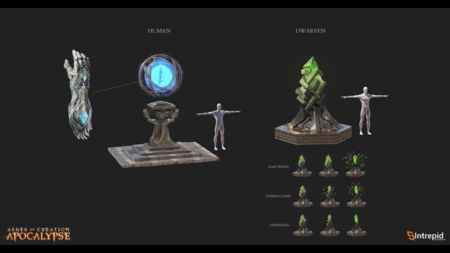
Each city has what's called a reliquary and the reliquary begins to spawn unique items for the citizens to take advantage of based on the performance, progression and achievements that those citizens have within the world. So if your citizens are part of downing a world boss or completing a dungeon in a record time or crafting a legendary item or whatever: all of these different types of progression paths for the cities could result in the production of a relic that exists within the reliquary.[28] – Steven Sharif
Relics are achievements for a node that unlock over time. They allow node citizens to craft certain legendary items and progress in certain legendary quest lines.[29][30]
- Relics are embodiments of certain types of achievements. You may have the scale of a dragon that's been defeated- the all-scale aspect of it- and from that every week a citizen might be able to derive one scale material component that can be used across a plethora of high-end types of crafting.[29] – Steven Sharif
- Relics automatically manifest in the node's reliquary when specific conditions are met by that node. For example, it may require a certain number of citizens to accomplish a particular achievement a number of times before the relic is granted to the node.[29][28]
- Let's say for example there is a dragon nearby and this dragon is a large raid boss; and the number of citizens that the node has that participates in that raid the first time- if you have 30 citizens present you may not achieve the relic. And it's not a matter of capturing it at that location taking back to the city. It'll automatically manifest within the reliquary if a number of citizens accomplish a particular achievement a number of times necessary to create the relic. So if you only have 30 citizens present at that raid boss you may need to do that raid boss four or five six times in order to unlock the achievement which grants the relic in the reliquary. So it's essentially incentivizing the citizens to participate in the world events around the node.[29] – Steven Sharif
- Relics can also be awarded for accomplishments that span many different progression paths, such the number of citizens achieving advanced stages of their artisan classes.[29]
- The other component of relics that's important to note is that it's not just adventuring relics, these are accomplishments that span a lot of the different progression paths. So you could have accomplishments get unlocked by how many number of citizens achieve the creation of a particular type of item. You may have now an alchemical genius that is a citizen of your node and as a result there is an alchemical relic that's been granted to your reliquary in a similar fashion to the dragon.[29] – Steven Sharif
- Relics stored in a node's reliquary grant passive and active benefits to node citizens and vassal states.[31]
- Limited access to the relics stored in a node's reliquary are granted to players after a node is destroyed by a node siege.[34][35][29][28][36][37][38] Benefits are also conferred to those who capture, steal, or sabotage relics held the reliquary.[31]
- Looting a relic from a node will create a shard of the relic, which can be used in recipes for certain crafted items and enchantments; or it can be consumed for a single-use buff that reflects the original relic's purpose.[39] These shards can be traded.[40]
- Relics include the four Ancient artifacts of Verra that were originally discovered by King Atrax in his pursuit of the power of The Essence.[41][42]
- These artifacts were in close alignment to The Essence on Verra due to their proximity to the ley lines of Essence spread across the world.[43]
- These artifacts were originally housed in the vault of Fallow's Hold, which is one of the great dungeons of Ashes of Creation, located near the capital city of the ancient Toren empire, Torall.[43]
- Constellations enable the acquisition of certain relics.[44]
- Certain relics can only be discovered through exploration.[45]
Node development
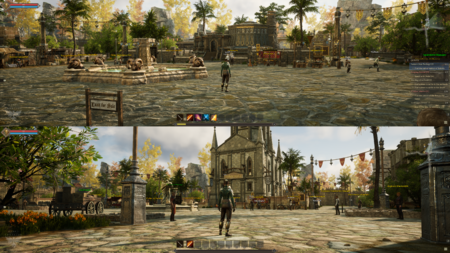
The layout and architecture within a Node’s development area are determined by influential race. For example, a stage 3 Node with the majority of player contribution being Py'rai would have a Py'rai village with Py'rai architecture. Most NPCs would be Py'rai elves, and offer questlines within the Py'rai narrative.[46] – Margaret Krohn
Each player’s contributed experience is flagged with their character race and other identifiers. When a Node advances, the race with the highest experience contribution determines the Node’s style and culture. This style and culture change can happen at every Node Stage. For example, if a Node advances to Level 2 - Encampment Stage and 51% of all experience was earned by Ren’Kai players, the Node will be a Level 2 Ren’Kai Node. If that same Node advances to a Level 3 - Village Stage Node, but the Py'Rai contributed 62% of all the experience earned, then the Node will be a Level 3 Py'Rai Node.[2] – Margaret Krohn
Node layout and style is determined by several factors:[47][48]
- The way that the node system is built is that they can exist across a spread of 18 biomes, but at the same time have to represent the cultural influence of these cultures that are intrinsically a part of a specific biome.[49] – Steven Sharif
- Environment (biome) and location of the node.[49][47][48]
- Nodes will adjust the local topography to fit the aesthetic and mechanical requirements of the node.[50]
- Currently the way that the platform system is set up, is it's capable of adjusting the topography of the node's footprint, regardless of the surrounding terrain. So the reason for that is we want to have flexibility in the presentation of the node's layout and how it is essentially both from an aesthetic standpoint as well as a mechanical standpoint with node sieges- how it's constructed and that construction should have the ability to take on a variance of different types of topography. So it shouldn't be dependent on the surrounding area. Now that's not to say that the surrounding area isn't going to have some influence over. So for example... we're experimenting a little bit with the platform tech and putting up a node up against the side of a mountain or on the edge of a cliff or something that has a beautiful vista. Those are things that we're going to test out obviously as we continue to work on the node tool and how that platform system works, but the idea is to have the node independent of the surrounding terrain.[50] – Steven Sharif
- Some parts are determined by the area it's in. Some parts are determined by the type it is. Some parts are determined by the race it is; and then the rest of it is determined by the mayor.[48] – Jeffrey Bard
- Race that contributed the highest percentage to the node's advancement will alter the racial appearance of its buildings, NPCs, and props.[51][52][47][2][48][53][54]
- All nodes, whether they're associated with a castle or associated with normal node structure, has cultural influences that replicate over to the buildings that are produced and the NPCs that are present.[56] – Steven Sharif
- The rest is determined by the node's mayor.[48]
- It should be possible for a node to complete several building projects within a mayor's one month term in office.[57]
- Q: How long would you say it will take players on average to fill/build up a node completely from wilderness to metropolis?
- A: It's one thing to get a node to a certain level: it's another thing to develop the node; and I can't really give you an on-average expectation, because there's a lot of variables at play. There's how many citizens does the node have attracted to it; what's the type of traffic that the node is attracting to it based on things like its tax rates, or the specialization that it chose to spec into, based on the building types it's chosen to build. All of those things are variables that can affect the quote-unquote "average build-out time" of a particular node. So it's difficult to give you an average when there's so many variables along those lines. But the idea is that if there is a particular project that players are interested in in developing based on the node stage, that they would have the ability to complete several of those projects as within a single term of a mayor; and a term of a mayor is one month.[57] – Steven Sharif
Node buildings
Racial quests
Quests may be based on a character's race.[58]
Different quests may relate to who the primary cultural contributor is to a node. This won't lock out content, but will add flavor to the quests.[58]
There might even be different directories of the quest that exist for specific races, and even though you're sharing a quest to kill a boss, if you're human and I'm an elf, I will have a different arc potentially that leads in a different direction than you, even though we took the same quest; and this can relate to who the primary cultural contributor is to a node unlocking different arcs for cultures that share the primary culture of a node - not that locks out content but it gives a flavor in a different direction so that not everything is so cookie cutter.[58] – Steven Sharif
Race matters because narratives have paths that also are influenced based on the primary contributing culture to the node... If you're a Niküa and you have you're in a Niküa node that's predominantly Niküa, you're going to have certain services and/or abilities as a member of the Niküa race that other races may not have access to... They may have alternative quest lines, but they won't have specific ones. Now those specific Niküa quests will then relate to the meta-narrative that's present in the world and they'll start to direct some of that meta-narrative; and that'll be beneficial for your kind because it will unlock certain content for your race that other races haven't unlocked yet. So there is an incentive there to see progression along that line now in order to curb the progress of a dominant race.[59] – Steven Sharif
Quests that are race specific, title specific, or guild specific will likely be less than 10% of the total number of quests. 90% of quests should be able to be shared by everybody.[60]
Trophy park
Trophy park is an area within Town, City or Metropolis nodes that has available spots for trophies. These trophies show the character names of players who are the first to complete world bosses and dungeon bosses that were spawned as the result of the development of that particular node.[61]
- Server announcements and achievements are designed to encourage groups to experience new content.[61]
Node government
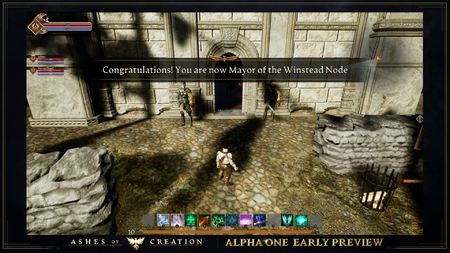
There are a number of different seats that can exist within a node, and carry different responsibilities.[63] – Steven Sharif
Positions within a node's government are attained through seasonal titles that grant special powers and benefits within the node.[64][63][65][23]
There are other node-based positions. Most of them relate to social organizational structures like the temple and the social organization building that the node might construct. Those are ladder systems of achievement that players can work through on a seasonal basis to achieve the highest level of that for the particular node; and by doing so they will then have titles bestowed upon them, which grants certain types of powers and benefits.[64] – Steven Sharif
- Mayors.[66]
- Priests, bishops, or acolytes of temples.[64][67][65]
- Social organization positions.[64]
- Patron guild leaders.[65]
- Chief bounty hunter.[65]
Leadership powers
Leadership powers may refer to.
Node taxes
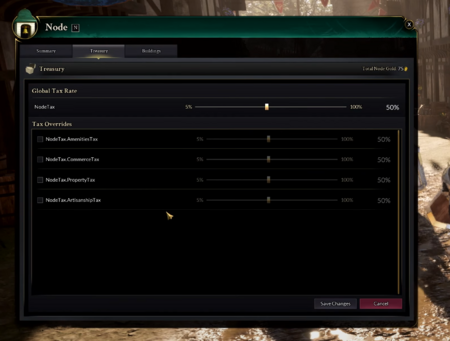
As the node levels up, you're gonna get access to deeper controls on the taxes, so that you as a Mayor can incentivize players to come to your node to do certain things. If you're a node that loves smithing, you're probably going to want to lower your taxes on artisanship to incentivize players to be here. But then you might want to drive up taxes on other avenues that players aren't necessarily coming to your node for, but are using out of convenience.[68] – Chris Justo
Mayors are able to set a generalized node tax rate as well as overrides for different activities within their node. Mayors gain additional taxation controls as their node advances.[68][69]
- Amenities tax override.[68]
- Artisanship tax override.[68]
- Commerce tax override.[68]
- This may include taxes that apply to tavern games.[70][71]
- Property tax override.[68]
- Freehold property taxes scale according to the number of freehold building permits issued for that freehold.[72][73][74]
- Citizenship dues and property taxes scale based on the stage of the node when a player became a citizen.[75][76][77][78][79]
- The goal is to exert financial pressure on node populations by making taxes increasingly expensive as nodes advance, rather than putting in place hard population caps.[77][78]
- Node tax rates will be visible on the world map by hovering over a node location.[80]
- Tax revenue only goes toward funding node development. This cannot be withdrawn by the mayor or any other player.[81][74]
Regent nodes take a cut of taxes from various activities that occur within their vassal node structure.[81][82]
- This tax doesn't necessarily impact the individual citizen, because citizen's tax levels are determined by their node, but the node's finances are affected by the taxation levied by its parent nodes.[82]
Alliances
Ashes of Creation may have specific content that revolves around Alliances.[83]
- Progression pathways within alliances.[83]
- Guilds sharing common services with alliance members.[83]
- Node alliances.[84][83]
- Content that revolves around alliances specifically and progression within the development of that alliance; and the ability to share some common services between guilds that are part of that alliance. I think that additionally allowing alliances to toggle certain relationships with nodes as an interaction is beneficial. That's going to provide an interesting dynamic for players who are either members of the particular node that has the relationship established or members of the Alliance. So I think that obviously building systems is is about creating the channels by which these players can form bonds and the more layers you have around those channels of bonding between the different guilds or players, the more sustainable that relationship.[83] – Steven Sharif
Stock exchanges (also called Stock markets and Share markets) enable players to buy and sell shares in Nodes, Guilds and Social organizations.[85][86][87]
- Stock exchanges were a Kickstarter stretch goal unlocked for reaching the $3 million dollar mark.[87]
- This is a planned feature for the launch of Ashes of Creation.[85]
- The value of stocks is influenced by world events and the performance of nodes, Social organizations or guilds.[88]
- Hard metrics, such as quest lines, nearby resources, citizen progression, and purchases of local real estate, will determine the value of purchasable shares.[87]
- There is no regulatory commission to restrict the purchase and sale of stocks.[88]
See also
References
- ↑ Video, February 29, 2024 (33:57).
- ↑ 2.0 2.1 2.2 2.3 2.4 2.5 Blog - Know Your Nodes - Advance and Destroy.
- ↑ A reactive world - Nodes.
- ↑ Video, April 20, 2017 (0:02).
- ↑
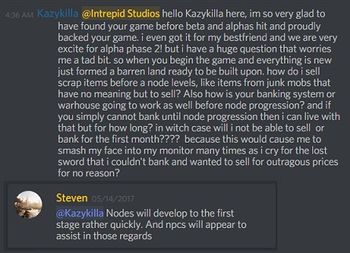
- ↑ Node series part II – the Metropolis.
- ↑ 7.0 7.1 Livestream, October 16, 2017 (50:20).
- ↑

- ↑

- ↑ Livestream, February 29, 2024 (53:58).
- ↑ 11.0 11.1 Interview, July 18, 2020 (10:04).
- ↑ 12.0 12.1 Interview, July 8, 2020 (1:00:15).
- ↑

- ↑ Livestream, September 24, 2021 (1:21:23).
- ↑ 15.0 15.1 Livestream, May 26, 2017 (28:16).
- ↑ 16.0 16.1 16.2 16.3 16.4 Livestream, October 14, 2022 (55:13).
- ↑ Livestream, November 17, 2017 (55:27).
- ↑ 18.0 18.1 Livestream, April 7, 2023 (58:39).
- ↑ 19.0 19.1 19.2 Video, March 31, 2023 (14:20).
- ↑ 20.0 20.1 Video, March 31, 2023 (12:47).
- ↑ 21.0 21.1 21.2 21.3 Interview, October 20, 2018 (2:36:25).
- ↑ Livestream, January 18, 2018 (39:08).
- ↑ 23.0 23.1 MMOGames interview, January 2017
- ↑ 24.0 24.1
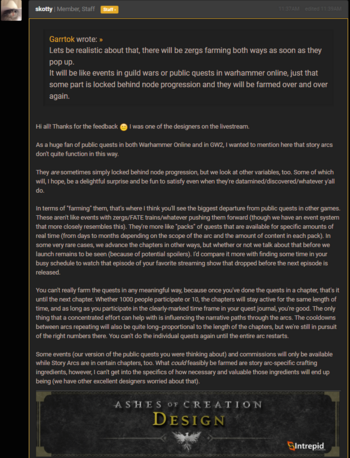
- ↑ Livestream, March 26, 2021 (1:12:51).
- ↑ Livestream, July 25, 2020 (1:50:20).
- ↑

- ↑ 28.0 28.1 28.2 Interview, July 18, 2020 (56:11).
- ↑ 29.0 29.1 29.2 29.3 29.4 29.5 29.6 Podcast, September 29, 2021 (10:49).
- ↑ Livestream, February 9, 2018 (29:26).
- ↑ 31.0 31.1 Livestream, April 29, 2022 (27:00).
- ↑ Livestream, July 25, 2020 (1:22:40).
- ↑ Livestream, June 26, 2020 (1:33:10).
- ↑ Livestream, October 14, 2022 (52:31).
- ↑ Podcast, September 29, 2021 (14:21).
- ↑ Interview, July 8, 2020 (57:46).
- ↑ Livestream, April 30, 2020 (1:14:44).
- ↑

- ↑

- ↑

- ↑ Livestream, November 8, 2020 (15:01).
- ↑ Livestream, November 8, 2020 (00:49).
- ↑ 43.0 43.1 Livestream, November 8, 2020 (07:58).
- ↑ Video, December 2, 2022 (11:11).
- ↑ Livestream, February 24, 2023 (6:51).
- ↑ Blog - Know Your Nodes - The Basics.
- ↑ 47.0 47.1 47.2 Livestream, October 30, 2020 (39:17).
- ↑ 48.0 48.1 48.2 48.3 48.4 48.5 Livestream, September 27, 2018 (53:06).
- ↑ 49.0 49.1 Livestream, February 25, 2022 (41:00).
- ↑ 50.0 50.1 Livestream, February 26, 2021 (1:12:18).
- ↑ Livestream, March 31, 2022 (4:57).
- ↑ Podcast, April 11, 2021 (29:47).
- ↑ Interview, May 11, 2018 (54:34).
- ↑ Livestream, May 26, 2017 (21:23).
- ↑ Podcast, April 11, 2021 (23:36).
- ↑ 56.0 56.1 Interview, May 11, 2018 (47:27).
- ↑ 57.0 57.1 Livestream, July 29, 2022 (1:13:09).
- ↑ 58.0 58.1 58.2 Podcast, April 23, 2018 (29:56).
- ↑ Interview, May 11, 2018 (1:00:19).
- ↑ Livestream, July 26, 2019 (1:13:23).
- ↑ 61.0 61.1 Podcast, August 4, 2018 (1:35:58).
- ↑ Livestream, March 28, 2020 (1:02:46).
- ↑ 63.0 63.1
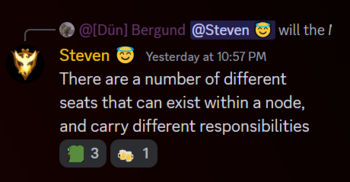
- ↑ 64.0 64.1 64.2 64.3 Livestream, September 29, 2023 (1:07:01).
- ↑ 65.0 65.1 65.2 65.3 Livestream, July 26, 2019 (1:20:48).
- ↑ Livestream, November 17, 2017 (9:49).
- ↑ Livestream, July 25, 2020 (1:52:45).
- ↑ 68.0 68.1 68.2 68.3 68.4 68.5 68.6 68.7 Video, August 31, 2023 (28:04).
- ↑ Livestream, March 28, 2020 (1:03:38).
- ↑

- ↑

- ↑ Interview, July 9, 2023 (54:46).
- ↑ Livestream, June 30, 2023 (1:45:22).
- ↑ 74.0 74.1

- ↑ Blog: Development Update with Village Node.
- ↑ Livestream, August 31, 2023 (15:51).
- ↑ 77.0 77.1 Interview, July 9, 2023 (38:14).
- ↑ 78.0 78.1 Interview, March 27, 2020 (0:30).
- ↑ Video, April 5, 2018 (41:48).
- ↑ Livestream, September 29, 2023 (1:11:22).
- ↑ 81.0 81.1 Livestream, August 26, 2022 (1:10:16).
- ↑ 82.0 82.1 Interview, May 11, 2018 (57:02).
- ↑ 83.0 83.1 83.2 83.3 83.4 Podcast, May 11, 2018 (21:07).
- ↑ Livestream, August 31, 2023 (2:10:23).
- ↑ 85.0 85.1

- ↑ 86.0 86.1 Livestream, May 17, 2017 (11:27).
- ↑ 87.0 87.1 87.2

- ↑ 88.0 88.1 Interview, October 20, 2018 (5:51).

